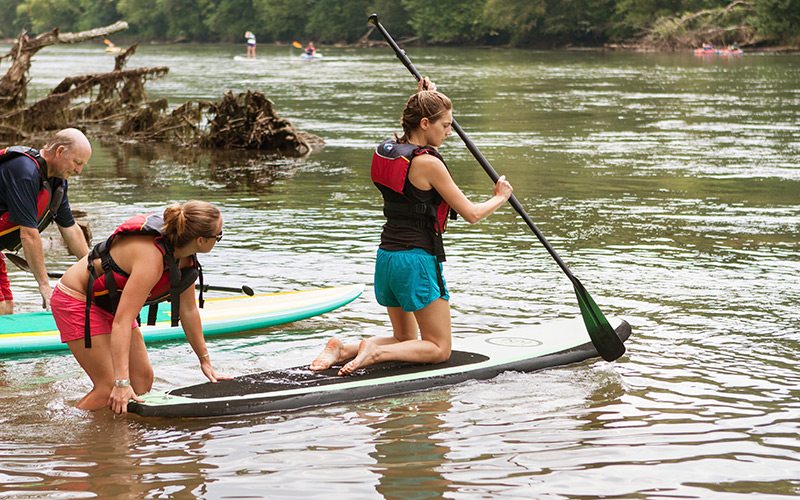

Dip a toe into stand-up paddleboarding with these basic skills for beginners, including standing and kneeling.
Stand-up paddleboarding (SUP) has exploded in popularity, and for good reason: It develops balance, strength, and endurance, without overtaxing a particular muscle or part of the body. According to the Sports and Fitness Industry Association, participation has swelled by nearly 24 percent in the United States in the past five years.
“SUP can be a serious sport and an excellent way to exercise,” says Zack Anchors, co-founder of Portland Paddle in Maine, which offers SUP instruction and guided tours in Casco Bay. “But first and foremost, it’s a great way to have fun on the water.”
If you’ve been curious about SUP, these tips will help you get started.
Take a Stand
Whether you’re in a lake, river, or ocean, begin by setting your board on the surface of the water, deep enough that the fin doesn’t touch ground. Lay your paddle just in front of the handle, which is typically in the center of the board. Then, standing alongside the board, place a hand on either side of the handle. Bring one knee up alongside the handle and then place the other knee on the other side. From this kneeling position, paddle at least 10 feet from the dock or shore before attempting to stand. Then, when you’re ready, bring one foot forward at a time, get into a squatting position, and stand upright.
Once you’re up, place your feet hip-width apart, on either side of the handle. Don’t plant your feet too close together or tense up, warns Emily Kirkton, the manager of Outdoor Discovery Field Operations for L.L. Bean in Maine. Keep the body loose, “like you’re standing on the subway,” she says.
Hands-On Learning
Keep one hand on the T-shaped grip at the paddle’s end and the other hand on its shaft. Your hands should be about shoulder-width apart. A grip that’s too narrow will overwork the smaller muscles in your arms; a grip that’s too wide will limit your stroke and could strain your back, says Ben Morton of Precision Paddlesports, a Virginia-based company that offers instruction, tours, and coaching.
Different Strokes
Paddling an SUP is similar to a canoe, Kirkton says. You’ll keep the shaft of the paddle vertical and the paddle blade perpendicular to the water throughout the stroke, relying on your torso, not your arms, for power.
To move forward, reach your paddle toward the nose (or front) of the board and bury the blade in the water. Using your core, pull the paddle toward you, removing the blade from the water just after it passes your feet.
To turn, you’ll use a forward sweep stroke: Bend your knees and bury the blade in the water, as close as possible to the nose of your board. Using your torso, sweep the blade outward as far as possible, and toward the board’s tail, in the shape of a “C.”
Paddleboards aren’t designed to back up, Morton says. To reverse direction, first you’ll need to stop by rotating the paddle in your hand so the back of the blade faces forward, bending at the knees to brace for the change in momentum. Place the blade in the water, just behind your feet, then push it forward toward the nose. Finally, to reverse course, take a series of short strokes, close to the board, to spin in the desired direction.
Fall for It
Falling is inevitable, so wear a personal flotation device (PFD), as well as a leash that attaches your ankle to the board and clothes that can get wet, Anchors says. You might even consider a wetsuit, depending on water temperature and wind conditions.
When you do tumble into the water, pulling yourself back onboard is much simpler than reboarding a kayak or canoe. First, position yourself alongside the board so that your body and the board form a “T” shape. Stretch your arms across the board, let your feet float to the water’s surface, and slide your belly onto the board. If you lost your paddle, lie on your belly and paddle with your hands to retrieve it. Return to a kneeling position and stand up.
Above all, don’t get discouraged, Kirkton says. “Experienced paddleboarders fall in all the time as they push the limits of their skills.”